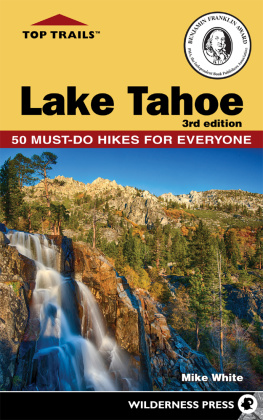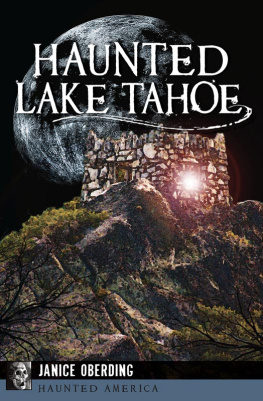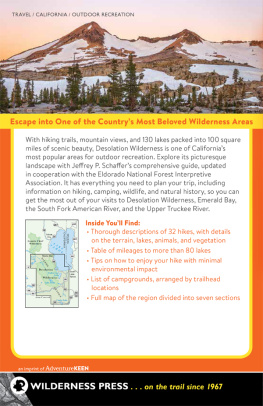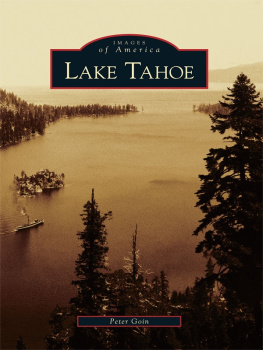A SHORT HISTORY OF
Lake Tahoe
MICHAEL J. MAKLEY
UNIVERSITY OF NEVADA PRESS
RENO & LAS VEGAS
University of Nevada Press, Reno, Nevada 89557 USA
Copyright 2011 by University of Nevada Press
All rights reserved
Manufactured in the United States of America
Design by Kathleen Szawiola
Library of Congress Cataloging-in-Publication Data
Makley, Michael J.
A short history of Lake Tahoe / Michael J. Makley.
p. cm.
Includes bibliographical references and index.
ISBN 978-0-87417-850-0 (pbk. : alk. paper)
1. Tahoe, Lake (Calif. and Nev.)History. 2. Natural historyTahoe, Lake (Calif. and Nev.) 3. Tahoe, Lake (Calif. and Nev.)Environmental conditions.
4. Tahoe, Lake, Region (Calif. and Nev.)History. 5. Tahoe, Lake, Region (Calif. and Nev.)Biography. I. Title.
F868.T2M35 2011
979.4'38dc22 2011013725
Frontispiece: Lake Tahoe from Cave Rock in the nineteenth century.
(Courtesy Special Collections, University of Nevada, Reno Library.)
ISBN 978-0-87417-866-1 (ebook)
For my brother, Kevin, and Stephen Ledyard
with whom I shared a magical time
growing up at Tahoe
Preface
People come to Lake Tahoe for many reasons. From its ten-thousand-foot peaks to its pine forests and sandy beaches, there is magic in this region. Temperatures are moderate in summer, and its winters produce beautiful snow-covered landscapes. Tourist attractions and outdoor recreation possibilities in all seasons are extraordinary. The area hosts the largest concentration of ski areas in North America while averaging more than three hundred sunny days a year. Yet its human and environmental histories are not widely known.
The lake is the center of Washoe Indian lands, and the tribe has an extensive mythology and oral history regarding its environs. Washoes see themselves as caretakers of the area's animals, land, water, and air. Over the course of many hundreds of years, they lived at the lake from spring until fall, and the natural environment prospered.
The relatively brief European American history at Tahoe begins in the middle of the nineteenth century. Awestruck by its beauty, arriving Americans nevertheless were intent on conquering the wilderness. They were acquisitive with an eye toward harvesting its abundant resources for use in distant vistas. Within a half century, the lake basin's forests and fisheries were destroyed, the water's remarkable clarity dramatically reduced.
Regenerated by the second half of the twentieth century, Tahoe's beauty led to ever-increasing numbers of residents and visitors and incessant building. Air quality and water clarity again suffered devastating effects. Disputes over the amount of human activity that should be allowed and to what degree conservation was needed continued into the twenty-first century. Scientific studies and political infighting eventually led to compromises involving residents, businesspeople, ecologists, and local and regional agencies. The cooperative efforts allowed protections to be put in place that today provide encouraging signs of another environmental revival.
This narrative describes the events, forces, and factors that have affected the course of developments in the lake basin while portraying the visionaries, schemers, and eccentrics who influenced them. In the end, the lake's history can be seen as a cautionary ecological tale as well as a fascinating story.
The concept of this book was proposed by Matt Becks Becker, University of Nevada Press editor. He has provided assistance and guidance in all its phases, steering the manuscript through the jury and editorial processes, and has earned my unreserved gratitude. Others who have lent invaluable help include former Nevada state archivist Guy Rocha; Nevada historian Robert Stewart; Laurel Ames, the first executive director of the Sierra Nevada Alliance; South Tahoe Public Utility District information officer Dennis Cocking; the late Dennis Oliver, Tahoe Regional Planning Agency; Bill Watson, manager of the Thunderbird Lodge Preservation Society; Alison Moore, California Historical Society librarian; and Darrel Bender and Art George Jr. of the Washoe Tribe. Assistance procuring photographs came from Donnelyn Curtis and Joel Guldner at the University of Nevada Special Collections; Bud Fawcett of Fawcett Photo Design; Amanda Royal and Cozette Alojzya Savage of the League to Save Lake Tahoe; Doug Haney and Katie Perhai of the U.S. Ski and Snowboard Association; Tom Millham, Lake Tahoe Wildlife Care; Tim Parsons, Tahoe Daily Tribune; Carole Morgan; and Jim Plehn. Line editor Annette Wenda's comprehensive knowledge and attention to detail enabled her to delete, add, and correct things that clarified and enhanced the text. I am indebted as well to University of Nevada Press director Joanne O'Hare, managing editor Sara Vlez Mallea, design manager Kathleen Szawiola, and marketing manager Barbara Berlin. I also wish to thank my mother, Dorothy Makley, who, based on her long Lake Tahoe residency, offered possibilities and sources for my research, and, as with each of my projects, Matthew Makley, who is an indispensable consultant. Finally, I owe a special debt to my wife, Randi Makley, for her steadfast support and boundless enthusiasm.
Introduction
Samuel Clemens sojourned at Lake Tahoe in 1861, two years before he would adopt his nom de plume, Mark Twain. In letters to his mother and sister, among other tributes, he called the lake the masterpiece of the Creation, and concluded, I had better stop about the lake, thoughfor whenever I think of it I want to go there and die, the place is so beautiful.
In Roughing It, using the name Mark Twain, he described seeing the lake from a mountain pass: We had heard a world of talk about the marvelous beauty of Lake Tahoe, and finally curiosity drove us thither to see it. As it lay there with the shadows of the mountains brilliantly photographed upon its still surface I thought it must surely be the fairest picture the whole earth affords. He went on to extol the virtues of camping at the lake: Three months of camp life on Lake Tahoe would restore an Egyptian mummy to his pristine vigor, and give him an appetite like an alligator. I do not mean the oldest and driest mummies, of course, but the fresher ones. The air up there in the clouds is very pure and fine, bracing and delicious. And why shouldn't it be?it is the same the angels breathe.
Lake Tahoe sits atop the northern Sierra Nevada, 6,225 feet above sea level. It is 22 miles long, 12 miles wide, and 1,636 feet deepthe third deepest lake in North America. Its waters are dissected by the California-Nevada state line, with approximately two-thirds of it in California. The lake basin is encompassed by the Sierra Nevada crest line on its west and the Great Carson Spur, or Carson Range, on its east.
The lake's environs are the product of millions of years of geologic evolution. The original mountain block was reconfigured by massive faulting during the late Cretaceous period. The fracturing, uplifting, and dropping resulted in a spacious basin surrounded by spectacular peaks that form the area's double summit. There is more than 6,300 feet of difference between Freel Peak, the basin's highest mountain at 10,881 feet, and the lake's deepest point.










